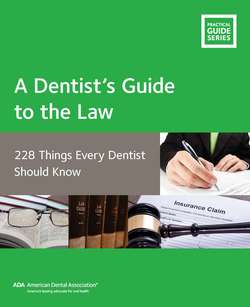Читать книгу A Dentist’s Guide to the Law - American Dental Association - Страница 31
На сайте Литреса книга снята с продажи.
16. Does a Limited Partnership Have Advantages Over a General Partnership?
ОглавлениеIt depends. A limited partnership differs from a general partnership in that it has two separate classes of membership: a general partner or partners, and limited partners. The general partners hold the management and decision-making authority for the practice. They also are individually charged with liability that might exceed the assets of the practice. The limited partners, on the other hand, do not have decision-making responsibilities, nor are they individually liable for liabilities of the practice (other than their own malpractice) that exceed their own investment in the business. In that sense, limited partners are much like individual stockholders in a public corporation. They have no real say in how the business is operated, but the most they can lose is the money they invested in their limited partnership interest.
At the same time, a limited partnership is similar to a general partnership in many ways. Partners associate together to share profits and expenses, and will have an extensive written agreement setting out the legal and financial elements of operating the practice, dealing with any termination of the business, admitting new partners, and so forth. The limited partnership files an informational tax return but taxes are paid by the individual dentist members, not the partnership itself.
A limited partnership requires more attention to detail and more filings than a general partnership. It can be formed only by making a statutory filing with the Secretary of State or similar governing office in the state of organization. A partnership agreement is essential for that filing and is more elaborate than a general partnership agreement. Annual filings with the state authority also are necessary, as well as federal and state income tax returns.
A limited partnership does have one important advantage over a general partnership, in addition to the fact that limited partners face a finite amount of risk on liabilities of the practice. Although the precise opportunities and limitations are well beyond the scope of this section, generally speaking, a limited partnership can slice and dice profits, losses, tax credits, required investments, and capital gain/loss in any way (proportionate or disproportionate) that the parties choose. To take some simple examples, a limited partner who has more assets to invest in the practice than the others might receive all the profits until that dentist has “recouped” his or her investment, and thereafter profits might be divided according to set percentages. A partner who has substantial other income — such as from a spouse — might negotiate to be allocated more of the anticipated early year losses from the practice. A partner who has substantial net operating loss carryovers from a prior business might want to be allocated more of the taxable income (but not cash flow).
Because of these tax advantages, limited partnerships are attractive formats for specific, one-time investment opportunities. One such example would be a real estate purchase, where certain investors are willing to invest money for profit but have no expertise or interest in managing the property, much less any desire to take on liability risk. The format is much less attractive for an operating business like a dental practice because a dentist who invests money in the practice will usually want to have a vote in how it is run. The new dentist who is associating with an established practice usually has little money to invest and is often taken on as an associate until such time as sufficient mutual trust is developed to allow that dentist to become a “full partner” and participant. At a point in a practice’s evolution when employees are being hired, income is increasing, perhaps a lengthy lease is contemplated, and substantial equipment purchases are being made, a corporation or limited liability company as the legal format may become increasingly attractive.
